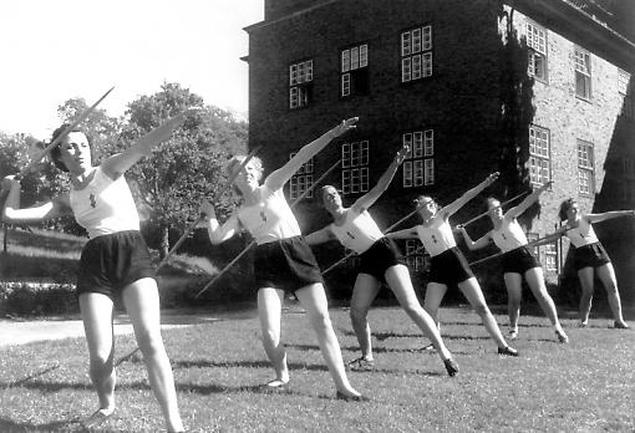 By Roger Moorhouse, New Statesman, October 3, 2013 Review of Hitler's Furies: German Women in the Nazi Killing Fields, by Wendy Lower, Chatto & Windus, 288pp, £18.99 It’s worth remembering here that many of those women who committed crimes could not resort to the time-worn excuse that they were “following orders”. They were not. The conventional image of women in Nazi Germany is well known. In what was a very masculine world, women generally appear either as hysterical, weeping Hitler fanatics or as hapless rape victims, reaping the Soviet whirlwind. Some readers, however – those familiar with the execrable concentration camp guards Irma Grese and Ilse Koch or perhaps with Bernhard Schlink’s novel The Reader – might recognise a third stereotype: that of the woman as perpetrator. Hitler’s Furies, a new book by the American academic Wendy Lower, brings this latter image to a non-specialist audience. Distilling many years of research into the Holocaust, Lower focuses her account on the experiences of a dozen or so subjects – not including Grese and Koch – ranging from provincial schoolteachers and Red Cross nurses to army secretaries and SS officers’ molls. Despite coming from all regions of Germany and all walks of life, what they had in common was that they ended up in the Nazi-occupied east, where they became witnesses, accessories or even perpetrators in the Holocaust. Lower is scrupulously fair to her subjects, providing a potted biography of each, explaining their social and political background and examining the various motives – ambition, love, a lust for adventure – that propelled them to the “killing fields”. This objectivity is admirable, particularly as most of the women swiftly conformed to Nazi norms of behaviour, at least in turning a blind eye to the suffering around them. One woman, a Red Cross nurse, organised “shopping trips” to hunt for bargains in the local Jewish ghetto, while another, a secretary, calmly typed up lists of Jews to be “liquidated”, then witnessed their subsequent deportation. Most shocking of all are the accounts of the women who killed. One of Lower’s subjects, a secretary-turned-SS-mistress, had the “nasty habit”, as one eyewitness put it, of killing Jewish children in the ghetto, whom she would lure with the promise of sweets before shooting them in the mouth with a pistol. Lower presents another chilling example: that of an SS officer’s wife in occupied Poland who discovered a group of six Jewish children who had escaped from a death-camp transport. A mother, she took them home, fed and cared for them, then led them out into the forest and shot each one in the back of the head. Despite these horrors, Lower’s book resists the temptation to wallow in emotive rhetoric; nor is it drily academic. She writes engagingly, wears her considerable erudition lightly and has opted to stick with a broad narrative account, comparing and contrasting but never allowing her analysis to outweigh the fundamental humanity of the stories. The book’s power lies in its restraint.
Neither can Hitler’s Furies be imagined as some sort of Woman’s Hour rereading of the Holocaust. There is no special pleading for the subjects and the gender studies aspect of the book is kept well within bounds. Indeed, in analysing the women’s progress from nurses and secretaries to accomplices and perpetrators, Lower is at times eager to emphasise that the forces that drove and shaped them were in some ways the same forces experienced by Germany’s men – the seductive appeal of Nazism, the heady lawlessness of the occupied eastern territories and the “new morality” of the SS. It’s worth remembering here that many of those women who committed crimes could not resort to the time-worn excuse that they were “following orders”. They were not. They were merely reacting and adapting to their surroundings. Consequently, Lower stresses that her subjects were not just marginal psychopaths; rather, they might be seen as perfect embodiments of the Nazi regime, products of the hideous, murderous times in which they lived. A gender-specific explanation is offered only tentatively: that the women simply got caught up in a heady vortex of power and anti-Semitic violence – the Ostrausch, or “intoxication of the east” – which was fuelled by their intimate relationships with the SS men around them. In the final chapter, Lower relates the fates of her subjects after the war, detailing the efforts made – or more often not made – to bring them to justice. Of the women she has studied, only one was tried and found guilty; the others benefited from a combination of a biased judiciary, a perceived lack of evidence and entrenched cultural prejudices about female innocence. Only the German Democratic Republic, Lower argues, was rigorous in pursuing wartime female perpetrators. Elsewhere, they quite literally got away with murder. Often harrowing and even disturbing, Lower’s book does not always make for comfortable reading. It is nonetheless well written and accessible enough to appeal far beyond an academic audience. Its errors are few and minor and, although it is a little surprising that a specialist on the Holocaust should misplace Gross-Rosen concentration camp, the author’s expertise is clearly evident throughout. With Hitler’s Furies, Wendy Lower has provided an important service in bringing the blind spot of women’s participation and implication in the Holocaust into focus. The new book shines a stark light on the ordinary women who accompanied the “ordinary men” of Christopher Browning’s landmark study of two decades ago into the abyss. Comments are closed.
|
CISA Blog
This blog provides selective critical analysis on developments in contemporary culture related to the subjects of antisemitism, racism, the Holocaust, genocide, and human rights.
|
© 2025 Canadian Institute for the Study of Antisemitism. All Rights Reserved.
 RSS Feed
RSS Feed